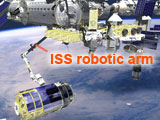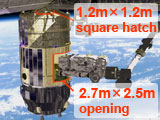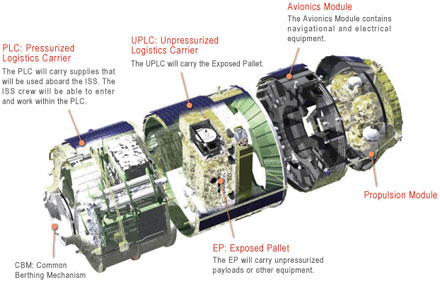The H-II Transfer Vehicle (HTV), built and developed in Japan, is an unmanned cargo transfer spacecraft that will deliver supplies to the International Space Station (ISS).
The HTV will be launched from the Tanegashima Space Center aboard an H-IIB launch vehicle with up to 6,000kg of supplies. When the HTV approaches close to the ISS, the Space Station Remote Manipulator System (SSRMS), known as "Canadarm2," will grapple the HTV and berth it to the ISS. After the supplies, such as food, clothes and a variety of experiment equipment, are unloaded, the HTV will then be loaded with waste materials, including used experiment equipment or used clothes. The HTV will then undock and separate from the ISS and reenter the atmosphere. While the HTV is berthed to the ISS, the ISS crew will be able to enter and remove the supplies from the HTV Pressurized Logistics Carrier.
 The HTV will slowly approach from the nadir (bottom) side of the ISS (from the direction of Earth), and stop (*1) at a designated position, which is approximately 10 meters away.
The HTV will slowly approach from the nadir (bottom) side of the ISS (from the direction of Earth), and stop (*1) at a designated position, which is approximately 10 meters away.
Once it is in position, the HTV will dock with the ISS. Rather than berthing in the traditional way, the HTV will come to a relative stop at a designated point, such described as "capture box" and the space station's robotic arm (SSRMS for Space Station Remote Manipulator System) will grab HTV's Grapple Fixture. This will be the first such spacecraft berthing ever carried out.
(*1) Although we say "stop," the ISS is actually orbiting the Earth at a speed of 7.7 kilometers per second, so obviously the HTV will also be moving at the same speed, but relatively speaking, we call such a state "stopped."
 In addition to Russia's cargo spacecraft, Progress, and the U.S. Space Shuttle, the Automated Transfer Vehicle (ATV), developed and built by the European Space Agency (ESA), and Japan's HTV will be utilized for delivering supplies to the ISS. Among these cargo-carrying spacecraft, the HTV is the only unmanned vehicle that can carry both pressurized and unpressurized cargo. This is a unique special feature of the HTV.
In addition to Russia's cargo spacecraft, Progress, and the U.S. Space Shuttle, the Automated Transfer Vehicle (ATV), developed and built by the European Space Agency (ESA), and Japan's HTV will be utilized for delivering supplies to the ISS. Among these cargo-carrying spacecraft, the HTV is the only unmanned vehicle that can carry both pressurized and unpressurized cargo. This is a unique special feature of the HTV.
Another advantage of the HTV is its 1.2 by 1.2 meters square hatch, which is larger than ATV's round hatch with a diameter of only 0.8 meter. Although HTV's cargo capacity is smaller than ATV's, its larger hatch size allows it to carry large objects such as experiment devices.
Under the current plan, the HTV will be the only cargo supplier that can carry large objects after the retirement of the Space Shuttle.
The Unpressurized Logistic Carrier (UPLC) has a big opening through which the Exposed Pallet (the pedestal to ship exposed experiment devices) can be directly taken out to space. The Exposed Pallet pulled out by the ISS's SSRMS will be passed to the Kibo's robotic arm to be attached to the Kibo's Exposed Facility. After replacing the already used experiment devices with the newly shipped ones, the Exposed Pallet will be put back in the UPLC.

Since June 2009, six astronauts have occupied the Space Station continuously. To support their stay, regular deliveries of food, clothing, various equipment, and other supplies are essential.
The HTV will be launched from the Tanegashima Space Center aboard an H-IIB launch vehicle with up to 6,000kg of supplies. When the HTV approaches close to the ISS, the Space Station Remote Manipulator System (SSRMS), known as "Canadarm2," will grapple the HTV and berth it to the ISS. After the supplies, such as food, clothes and a variety of experiment equipment, are unloaded, the HTV will then be loaded with waste materials, including used experiment equipment or used clothes. The HTV will then undock and separate from the ISS and reenter the atmosphere. While the HTV is berthed to the ISS, the ISS crew will be able to enter and remove the supplies from the HTV Pressurized Logistics Carrier.
Special feature 1: First spacecraft berthing using ISS robotic arm
 The HTV will slowly approach from the nadir (bottom) side of the ISS (from the direction of Earth), and stop (*1) at a designated position, which is approximately 10 meters away.
The HTV will slowly approach from the nadir (bottom) side of the ISS (from the direction of Earth), and stop (*1) at a designated position, which is approximately 10 meters away.Once it is in position, the HTV will dock with the ISS. Rather than berthing in the traditional way, the HTV will come to a relative stop at a designated point, such described as "capture box" and the space station's robotic arm (SSRMS for Space Station Remote Manipulator System) will grab HTV's Grapple Fixture. This will be the first such spacecraft berthing ever carried out.
(*1) Although we say "stop," the ISS is actually orbiting the Earth at a speed of 7.7 kilometers per second, so obviously the HTV will also be moving at the same speed, but relatively speaking, we call such a state "stopped."
Special feature 2: Shipping both pressurized and unpressurized cargoes
 In addition to Russia's cargo spacecraft, Progress, and the U.S. Space Shuttle, the Automated Transfer Vehicle (ATV), developed and built by the European Space Agency (ESA), and Japan's HTV will be utilized for delivering supplies to the ISS. Among these cargo-carrying spacecraft, the HTV is the only unmanned vehicle that can carry both pressurized and unpressurized cargo. This is a unique special feature of the HTV.
In addition to Russia's cargo spacecraft, Progress, and the U.S. Space Shuttle, the Automated Transfer Vehicle (ATV), developed and built by the European Space Agency (ESA), and Japan's HTV will be utilized for delivering supplies to the ISS. Among these cargo-carrying spacecraft, the HTV is the only unmanned vehicle that can carry both pressurized and unpressurized cargo. This is a unique special feature of the HTV.Another advantage of the HTV is its 1.2 by 1.2 meters square hatch, which is larger than ATV's round hatch with a diameter of only 0.8 meter. Although HTV's cargo capacity is smaller than ATV's, its larger hatch size allows it to carry large objects such as experiment devices.
Under the current plan, the HTV will be the only cargo supplier that can carry large objects after the retirement of the Space Shuttle.
The Unpressurized Logistic Carrier (UPLC) has a big opening through which the Exposed Pallet (the pedestal to ship exposed experiment devices) can be directly taken out to space. The Exposed Pallet pulled out by the ISS's SSRMS will be passed to the Kibo's robotic arm to be attached to the Kibo's Exposed Facility. After replacing the already used experiment devices with the newly shipped ones, the Exposed Pallet will be put back in the UPLC.
HTV Specifications
HTV is four meters across and about 10 meters long, a size large enough to accommodate a sightseeing bus. It consists primarily of three parts: (1) A propulsion module installed at the rear and composed of main engines for orbit change, Reaction Control System (RCS) thrusters for position control, fuel and oxidizing reagent tanks, and high-pressure air tanks; (2) An avionics module installed in the center part, with electronic equipment for guidance control, power supply, and telecommunications data processing; and (3) A logistics carrier that stores supplies.
HTV specifications
| Item | Specification |
|---|---|
| Length | Approx. 10m (including thrusters) |
| Diameter | Approx. 4.4m |
| Total Mass | Approx. 10,500kg |
| Cargo capacity (supplies and equipment) |
Approx. 6,000kg -Pressurized cargo: 4,500kg -Unpressurized cargo: 1,500kg |
| Cargo capacity (waste) | Approx. 6,000kg |
| Target orbit to ISS | Altitude: 350km to 460km Inclination: 51.6 degrees |
| Maximum duration of a mission | Solo flight: Approx. 100 hours Stand-by (on orbit): More than a week Berthed with the ISS: Maximum 30 days |
Key word: International Space Station (ISS)
The International Space Station (ISS) represents a global partnership of fifteen nations. The ISS is a versatile research institute and a large observation platform in the unique environment of outer space. In this international project, Japan participates with its first manned space facility, Japanese Experiment Module "Kibo". "Kibo" means "hope" in Japanese.Since June 2009, six astronauts have occupied the Space Station continuously. To support their stay, regular deliveries of food, clothing, various equipment, and other supplies are essential.

